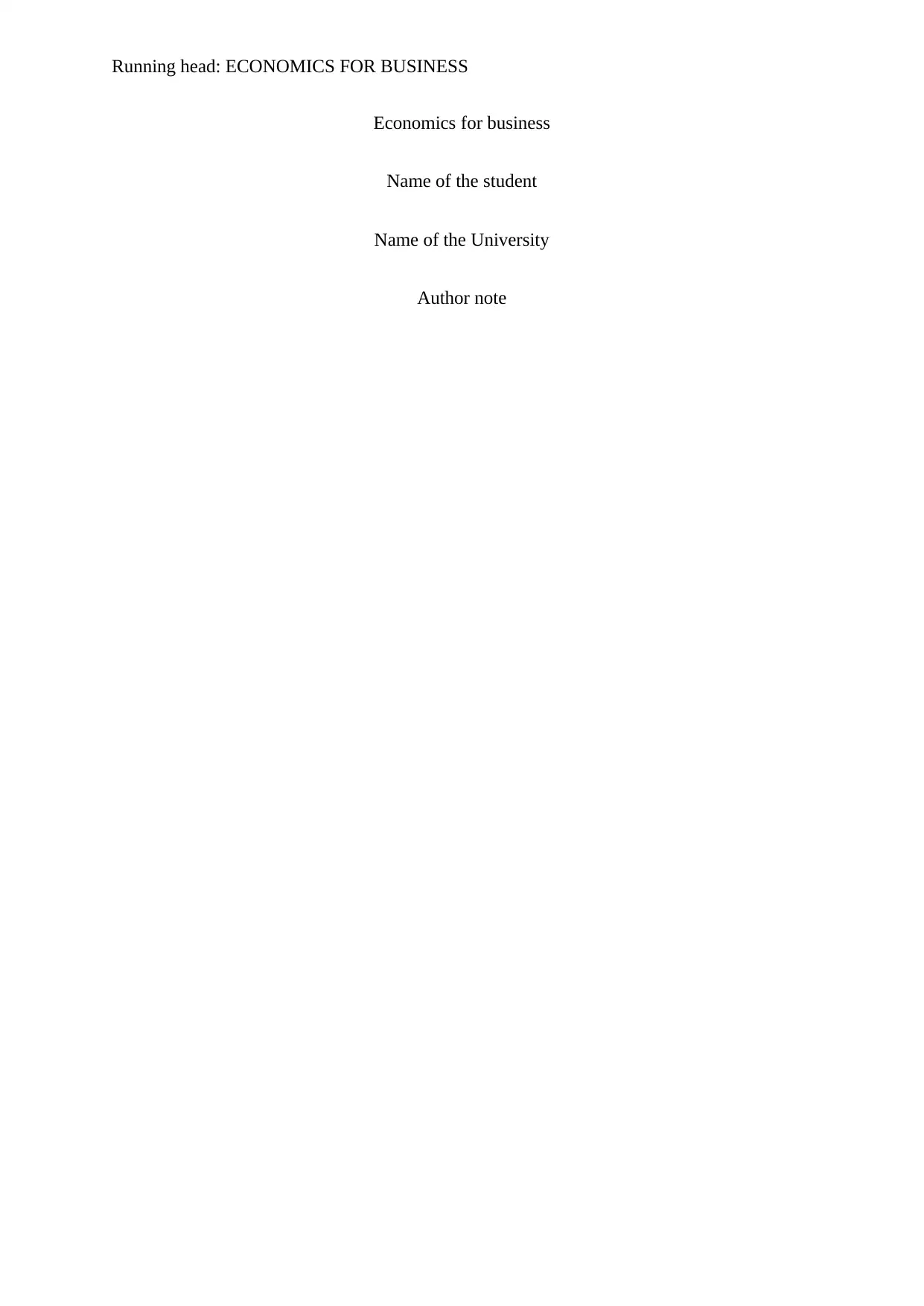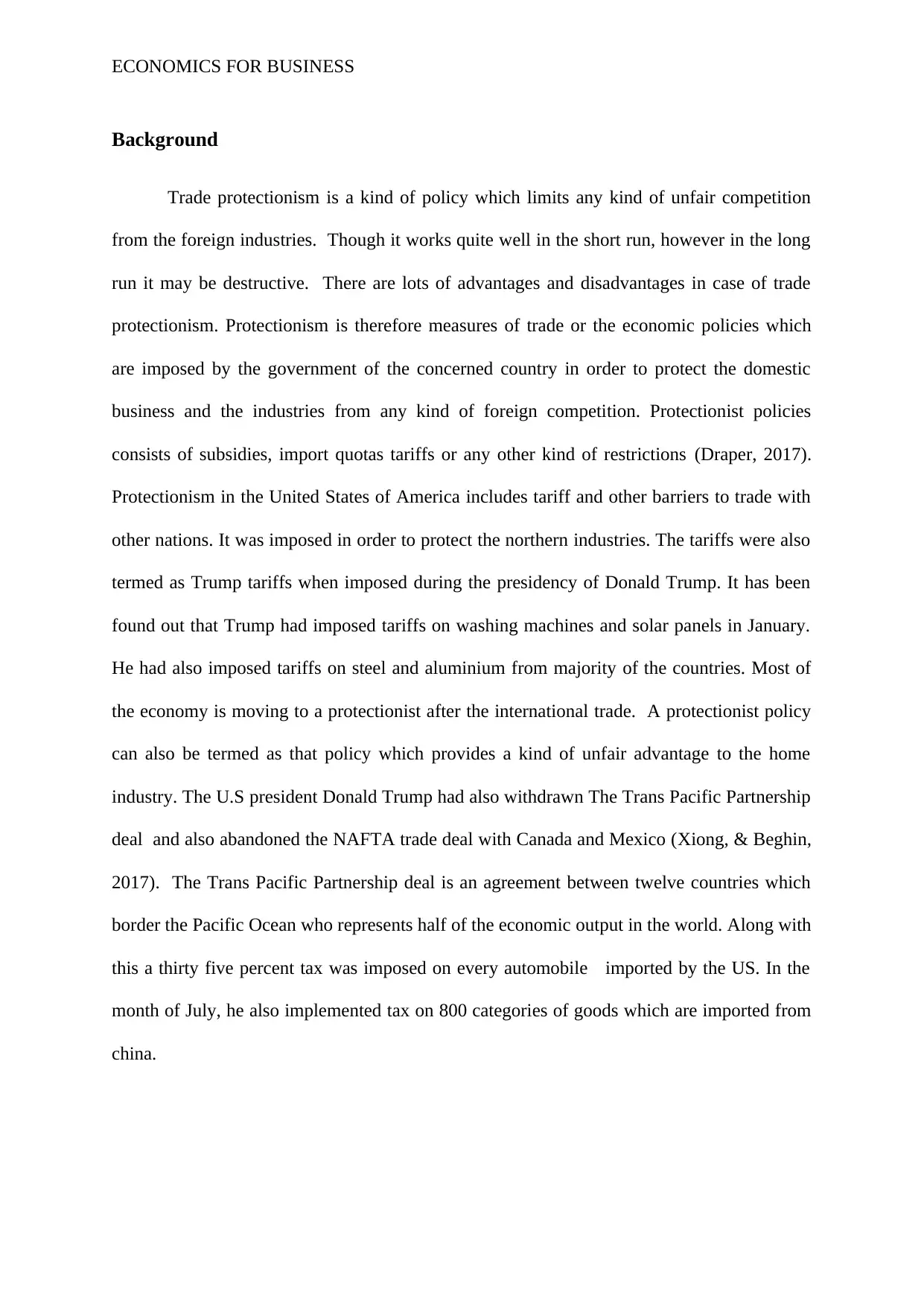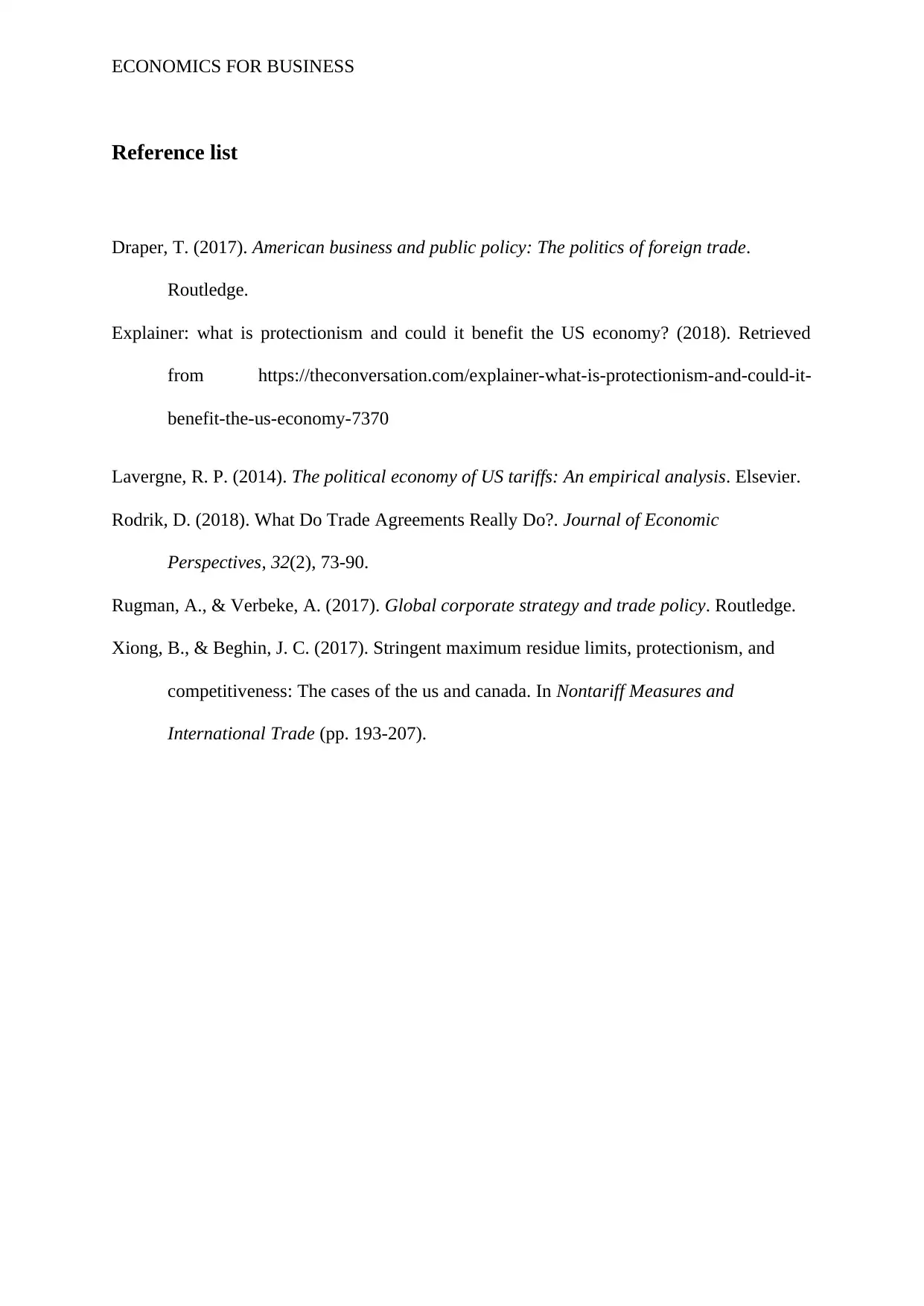Effects of Trade Protectionism on the US Economy: An Economics Report
VerifiedAdded on 2023/06/04
|6
|1113
|305
Report
AI Summary
This economics report examines trade protectionism, specifically focusing on the policies implemented by the US, including tariffs imposed during the Trump administration. The report provides a background on trade protectionism, defining it as a policy aimed at protecting domestic businesses from foreign competition through measures like tariffs and quotas. It analyzes the effects of these policies, particularly the impact of tariffs on imports, domestic producers, and consumers, using a graphical representation to illustrate the effects. The report discusses both the short-run and long-run effects of protectionism, highlighting potential benefits such as job creation and preventing dumping, while also addressing the risks of slower global growth, price wars, and reduced competitiveness. It concludes by referencing the impact of protectionist policies on international relations and economic growth, offering a comprehensive overview of the topic.

Running head: ECONOMICS FOR BUSINESS
Economics for business
Name of the student
Name of the University
Author note
Economics for business
Name of the student
Name of the University
Author note
Paraphrase This Document
Need a fresh take? Get an instant paraphrase of this document with our AI Paraphraser

ECONOMICS FOR BUSINESS
Background
Trade protectionism is a kind of policy which limits any kind of unfair competition
from the foreign industries. Though it works quite well in the short run, however in the long
run it may be destructive. There are lots of advantages and disadvantages in case of trade
protectionism. Protectionism is therefore measures of trade or the economic policies which
are imposed by the government of the concerned country in order to protect the domestic
business and the industries from any kind of foreign competition. Protectionist policies
consists of subsidies, import quotas tariffs or any other kind of restrictions (Draper, 2017).
Protectionism in the United States of America includes tariff and other barriers to trade with
other nations. It was imposed in order to protect the northern industries. The tariffs were also
termed as Trump tariffs when imposed during the presidency of Donald Trump. It has been
found out that Trump had imposed tariffs on washing machines and solar panels in January.
He had also imposed tariffs on steel and aluminium from majority of the countries. Most of
the economy is moving to a protectionist after the international trade. A protectionist policy
can also be termed as that policy which provides a kind of unfair advantage to the home
industry. The U.S president Donald Trump had also withdrawn The Trans Pacific Partnership
deal and also abandoned the NAFTA trade deal with Canada and Mexico (Xiong, & Beghin,
2017). The Trans Pacific Partnership deal is an agreement between twelve countries which
border the Pacific Ocean who represents half of the economic output in the world. Along with
this a thirty five percent tax was imposed on every automobile imported by the US. In the
month of July, he also implemented tax on 800 categories of goods which are imported from
china.
Background
Trade protectionism is a kind of policy which limits any kind of unfair competition
from the foreign industries. Though it works quite well in the short run, however in the long
run it may be destructive. There are lots of advantages and disadvantages in case of trade
protectionism. Protectionism is therefore measures of trade or the economic policies which
are imposed by the government of the concerned country in order to protect the domestic
business and the industries from any kind of foreign competition. Protectionist policies
consists of subsidies, import quotas tariffs or any other kind of restrictions (Draper, 2017).
Protectionism in the United States of America includes tariff and other barriers to trade with
other nations. It was imposed in order to protect the northern industries. The tariffs were also
termed as Trump tariffs when imposed during the presidency of Donald Trump. It has been
found out that Trump had imposed tariffs on washing machines and solar panels in January.
He had also imposed tariffs on steel and aluminium from majority of the countries. Most of
the economy is moving to a protectionist after the international trade. A protectionist policy
can also be termed as that policy which provides a kind of unfair advantage to the home
industry. The U.S president Donald Trump had also withdrawn The Trans Pacific Partnership
deal and also abandoned the NAFTA trade deal with Canada and Mexico (Xiong, & Beghin,
2017). The Trans Pacific Partnership deal is an agreement between twelve countries which
border the Pacific Ocean who represents half of the economic output in the world. Along with
this a thirty five percent tax was imposed on every automobile imported by the US. In the
month of July, he also implemented tax on 800 categories of goods which are imported from
china.

P2
P1
S
Q1 Q2 Q3 Q4
Tariff
D
1 2
3 4
ECONOMICS FOR BUSINESS
Effect of trade protectionism proposed by Trump
In this case Trump has imposed tariffs on the imported goods. Tariffs are tax imposed
on imports which can brought from other foreign markets. The government here tries to
restrict imports of foreign goods and services in order to protect the domestic industries and
companies which manufacture the same items. Tariffs will also help the domestic producers
to raise tax revenue. When a country is trying to grow strong in any kind of new industry,
imposing tariffs will protect them from foreign competitors (Explainer: what is protectionism
and could it benefit the US economy?, 2018).The tariff will then also help the new industry
develop the comparative advantage. In the short run tariffs also help in providing jobs for the
domestic workers. However, in the long run trade protectionism like tariffs will hamper the
industry. When there is any absence of competition companies in domestic markets will not
innovate. Therefore, the domestic product will then decline in quality and eventually it will
become more expensive when compared to the foreign goods.
Effect of tariff
P1
S
Q1 Q2 Q3 Q4
Tariff
D
1 2
3 4
ECONOMICS FOR BUSINESS
Effect of trade protectionism proposed by Trump
In this case Trump has imposed tariffs on the imported goods. Tariffs are tax imposed
on imports which can brought from other foreign markets. The government here tries to
restrict imports of foreign goods and services in order to protect the domestic industries and
companies which manufacture the same items. Tariffs will also help the domestic producers
to raise tax revenue. When a country is trying to grow strong in any kind of new industry,
imposing tariffs will protect them from foreign competitors (Explainer: what is protectionism
and could it benefit the US economy?, 2018).The tariff will then also help the new industry
develop the comparative advantage. In the short run tariffs also help in providing jobs for the
domestic workers. However, in the long run trade protectionism like tariffs will hamper the
industry. When there is any absence of competition companies in domestic markets will not
innovate. Therefore, the domestic product will then decline in quality and eventually it will
become more expensive when compared to the foreign goods.
Effect of tariff
⊘ This is a preview!⊘
Do you want full access?
Subscribe today to unlock all pages.

Trusted by 1+ million students worldwide

ECONOMICS FOR BUSINESS
Fig1: Effect of Tariff.
The above diagram shows that the tariff is between P1 and P2. Before imposing tariff
the import was Q4Q1. After government imposed tariff, the import declined to Q3Q2. The
Government receives a tariff revenue of Q3. The consumer surplus falls down by 1+2+3+4.
The imposition of tariff will raise the world supply curve. After the imposition of tariff the
price rises to P2. The domestic consumers faces high prices along with loss in the consumer
surplus. There has also been a net welfare loss of amount 2+4.
Short run and long run effect of trade protectionism
Although trade protectionism can benefit the domestic industries in the short run, it
can lead to slower global growth in the long run. In the long run protectionism can also lead
to instability which can lead to conflicts between countries. Trade protectionism also protects
jobs and industries. In the long run trade protectionism can result in price war among nations.
Increasing protectionism in the United States will also slower the economic growth which
can also result to more layoffs (Explainer: what is protectionism and could it benefit the US
economy? 2018). When United States will impose tariffs the other countries will follow the
same which will cause more layoffs. However, tariffs have many advantages and
disadvantages. Trade protectionism can also prevent dumping. Tariffs can discourage trade as
well as imports. Tariffs also discourages competition. It also discourages foreign investors
from investing in the domestic countries which will have a negative impact on the economy.
Protectionism can make domestic firms much less competitive in the export market. Tariffs in
the short run will protect the local industries from collapsing. Tariffs will also discourage the
foreign industries from importing goods that are cheap and hence they product the local
industries (Draper, 2017). Tariff also reduces dumping that is it protects the country from
being a recipient of goods that have been often rejected from other countries. In the long run
Fig1: Effect of Tariff.
The above diagram shows that the tariff is between P1 and P2. Before imposing tariff
the import was Q4Q1. After government imposed tariff, the import declined to Q3Q2. The
Government receives a tariff revenue of Q3. The consumer surplus falls down by 1+2+3+4.
The imposition of tariff will raise the world supply curve. After the imposition of tariff the
price rises to P2. The domestic consumers faces high prices along with loss in the consumer
surplus. There has also been a net welfare loss of amount 2+4.
Short run and long run effect of trade protectionism
Although trade protectionism can benefit the domestic industries in the short run, it
can lead to slower global growth in the long run. In the long run protectionism can also lead
to instability which can lead to conflicts between countries. Trade protectionism also protects
jobs and industries. In the long run trade protectionism can result in price war among nations.
Increasing protectionism in the United States will also slower the economic growth which
can also result to more layoffs (Explainer: what is protectionism and could it benefit the US
economy? 2018). When United States will impose tariffs the other countries will follow the
same which will cause more layoffs. However, tariffs have many advantages and
disadvantages. Trade protectionism can also prevent dumping. Tariffs can discourage trade as
well as imports. Tariffs also discourages competition. It also discourages foreign investors
from investing in the domestic countries which will have a negative impact on the economy.
Protectionism can make domestic firms much less competitive in the export market. Tariffs in
the short run will protect the local industries from collapsing. Tariffs will also discourage the
foreign industries from importing goods that are cheap and hence they product the local
industries (Draper, 2017). Tariff also reduces dumping that is it protects the country from
being a recipient of goods that have been often rejected from other countries. In the long run
Paraphrase This Document
Need a fresh take? Get an instant paraphrase of this document with our AI Paraphraser

ECONOMICS FOR BUSINESS
tariffs will have negative effect in the economy. Tariffs also affects the international relations
with other countries.
tariffs will have negative effect in the economy. Tariffs also affects the international relations
with other countries.

ECONOMICS FOR BUSINESS
Reference list
Draper, T. (2017). American business and public policy: The politics of foreign trade.
Routledge.
Explainer: what is protectionism and could it benefit the US economy? (2018). Retrieved
from https://theconversation.com/explainer-what-is-protectionism-and-could-it-
benefit-the-us-economy-7370
Lavergne, R. P. (2014). The political economy of US tariffs: An empirical analysis. Elsevier.
Rodrik, D. (2018). What Do Trade Agreements Really Do?. Journal of Economic
Perspectives, 32(2), 73-90.
Rugman, A., & Verbeke, A. (2017). Global corporate strategy and trade policy. Routledge.
Xiong, B., & Beghin, J. C. (2017). Stringent maximum residue limits, protectionism, and
competitiveness: The cases of the us and canada. In Nontariff Measures and
International Trade (pp. 193-207).
Reference list
Draper, T. (2017). American business and public policy: The politics of foreign trade.
Routledge.
Explainer: what is protectionism and could it benefit the US economy? (2018). Retrieved
from https://theconversation.com/explainer-what-is-protectionism-and-could-it-
benefit-the-us-economy-7370
Lavergne, R. P. (2014). The political economy of US tariffs: An empirical analysis. Elsevier.
Rodrik, D. (2018). What Do Trade Agreements Really Do?. Journal of Economic
Perspectives, 32(2), 73-90.
Rugman, A., & Verbeke, A. (2017). Global corporate strategy and trade policy. Routledge.
Xiong, B., & Beghin, J. C. (2017). Stringent maximum residue limits, protectionism, and
competitiveness: The cases of the us and canada. In Nontariff Measures and
International Trade (pp. 193-207).
⊘ This is a preview!⊘
Do you want full access?
Subscribe today to unlock all pages.

Trusted by 1+ million students worldwide
1 out of 6
Related Documents
Your All-in-One AI-Powered Toolkit for Academic Success.
+13062052269
info@desklib.com
Available 24*7 on WhatsApp / Email
![[object Object]](/_next/static/media/star-bottom.7253800d.svg)
Unlock your academic potential
Copyright © 2020–2025 A2Z Services. All Rights Reserved. Developed and managed by ZUCOL.





